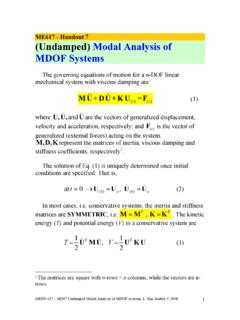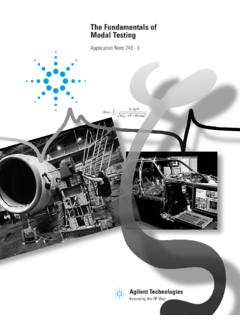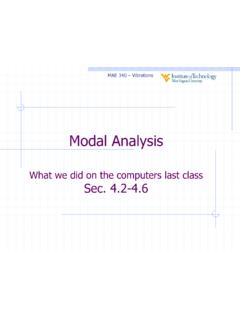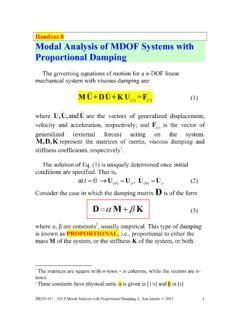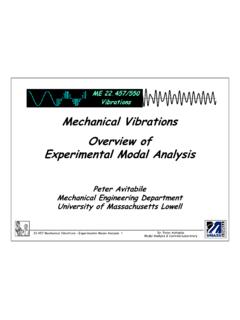Transcription of Identification of modal parameters of a mdof system by ...
1 JOURNAL OFSOUND ANDVIBRATIONJ ournal of Sound and Vibration 295 (2006) 827 837 Identification of modal parameters of a mdof systemby modified L P wavelet packetsArunasis Chakrabortya, Biswajit Basua, , Mira MitrabaDepartment of Civil, Structural and Environmental Engineering, Trinity College Dublin, IrelandbDepartment of Aerospace Engineering, Indian Institute of Science, Bangalore, IndiaReceived 21 May 2003; received in revised form 11 January 2006; accepted 24 January 2006 Available online 11 April 2006 AbstractIn this paper a methodology for identification of modal parameters of a structural system using wavelet analysis isproposed. The proposed technique differs from the other works on using wavelet for this problem in the choice of the basisfunction.
2 A modified form of Littlewood Paley (L P) basis function is used for the identification of the parameters . Thisbasis has the advantage being more closely representing a vibrating signal. Further it is localized in frequency and hencecan be used to detect the frequency and the associated parameters better. With a modification, it is well suited for sub-bandcoding to detect the parameters with desired accuracy. The current work identifies modal parameters such as naturalfrequencies and mode shapes of a linear multi-degree of freedom (mdof) system using the wavelet transform. It utilizeswavelet transform to identify natural frequencies and the corresponding mode shapes from the transient response of thesystem under ambient vibration condition.
3 The estimated natural frequencies and the mode shapes are found to be close tothe theoretical values for two simulated 3 and 5 dof systems. This demonstrates the effectiveness of the proposedmethodology for system Elsevier Ltd. All rights IntroductionIdentification of structural systems involves an inverse procedure to identify the structural parameters fromthe recorded response of real-world structures. The goal is to estimate the dynamic properties such as naturalfrequencies and mode shapes of vibration, energy dissipation, permanent deformation and strengthdeterioration of damaged structures from the responses of structures under different conditions like ambientvibration, earthquakes and several other types of excitations.
4 system identification of structures is thepreceding step for design of active and passive control of structures[1]and structural health monitoring[2 4].Identified parameters provide design criterion for structures subjected to seismic and other loadings inducingnonlinearity in structures[5,6]. modal analysis of the response of structures is an important tool for identification of a structural frequencies of a structure depend on its mass and stiffness distributions. The deformation patterns atARTICLE IN $ - see front matterr2006 Elsevier Ltd. All rights Corresponding (A. Chakraborty), (B. Basu), (M. Mitra).these frequencies or the mode shapes are informative of the natural characteristics of the structures.
5 Analysisof response signals of structures may be performed in two different paradigms: (i) time-domain analysis and(ii) frequency-domain analysis . Several approaches to time-domain system identification has been developedlike state estimation using Kalman filter[7], stochastic analysis and modeling, recursive modeling and least-squares classical method of frequency-domain analysis is by means of Fourier transform[8], and its algorithmicimplementation, the discrete Fourier transformation (DFT). Though DFT has been widely used for modalanalysis and other system identification tasks, it has several limitations. Fourier analysis is inherently global innature and fails to capture the time varying nature of a phenomenon.
6 An approach for signal analysis , whichcircumvents the above problem, is the time frequency analysis [9 13]. In the framework of multi-resolutiontime frequency analysis , wavelet methods developed by several researchers[14 16]have been widely popularand successful for signal analysis . Wavelets produce representation of a signal using time-limited localfunctions having variable scales. Wavelet analysis has recently been used for a number of system identificationtasks[17]. There have been several research works in literature on the use of wavelet to identify the modalparameters[18,19]. In some of these studies modal frequency, mode shapes and modal damping wereidentified. Random decrement technique has been used in some studies, which is known to have certaindrawbacks.
7 A shifted version of wavelet transform proposed by Staszewski[20]was used to detect works better for closely spaced frequencies. In Ref.[18], modified Morlet wavelet was used which worksbetter than the traditional Morlet wavelet. Though some studies on use of wavelets have been carried out insystem identification, yet it remains to be seen how different wavelets perform or which would be the this paper a methodology is proposed for identification of the modal frequencies and mode shapes of astructure using the real version of the Harmonic wavelet transformation for time frequency analysis . Thisworks better being close to vibrating signals. Further, this can be used to develop a sub-band coding leading tothe wavelet packets for better accuracy as desired.
8 The basis is also localized in frequency and hence does notsuffer from the problem of band overlapping. The technique is presented for extracting the modal parametersof a linear multi-degree of freedom (mdof) system by decomposition of the original signal into frequencybands via wavelet transform, and time-dependent analysis of each band using the basic properties ofeigenvalues of vibration modes. Two example cases of 3 dof and 5 dof linear viscously damped systems havebeen considered here. The vibration data are generated by simulating the response of the damped mdofsystems under free vibration conditions. The response signals are used to identify the modal Harmonic Wavelet transformThe wavelet transform has been used by researchers for several applications such as filtering, transientanalysis, time frequency analysis , non-stationary analysis , discontinuity detection, data compression, systemidentification and damage detection among many others.
9 The capability of the wavelet for carrying outtime frequency analysis has been exploited in this paper for the identification of modal parameters of a mdofdynamical wavelet analysis a signalx(t), a function of timet, is expressed as a composition of several time localizedshifted and scaled basis functions,c t b =a where b and a are the shifting and scaling parameters ,respectively. The shift or translational parameter centers the wavelet function so that information can beobtained about the signal around the locationt b. The dilation or scale parameter, a can be varied tocompress or extend the basis function to control the range of frequencies about which information can beobtained in the vicinity of the locationt b, by wavelet transformation.
10 Wavelet transform converts an initialdata sequence representing a chosen length of input signalx(t) into a new 2-D sequence, which consists of thecoefficientsWcx(a,b) and is defined byWcx a;b 1ffiffiffiapZ 1 1xt ct ba dt.(1)ARTICLE IN PRESSA. Chakraborty et al. / Journal of Sound and Vibration 295 (2006) 827 837828 The wavelet transform is an integral transform which convolutes the wavelet basis functionc(t), called themother wavelet with the functionx(t) being analyzed to generate the wavelet coefficients. The waveletcoefficients expressed in Eq. (1) provides temporal information of the functionx(t) at a scale of a corresponding to the frequencies at that scale given by the Fourier transformation of 1=ffiffiffiap c t b =a ao e iob;c_ o being the Fourier transform of the mother basisc(t).

